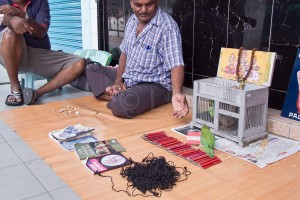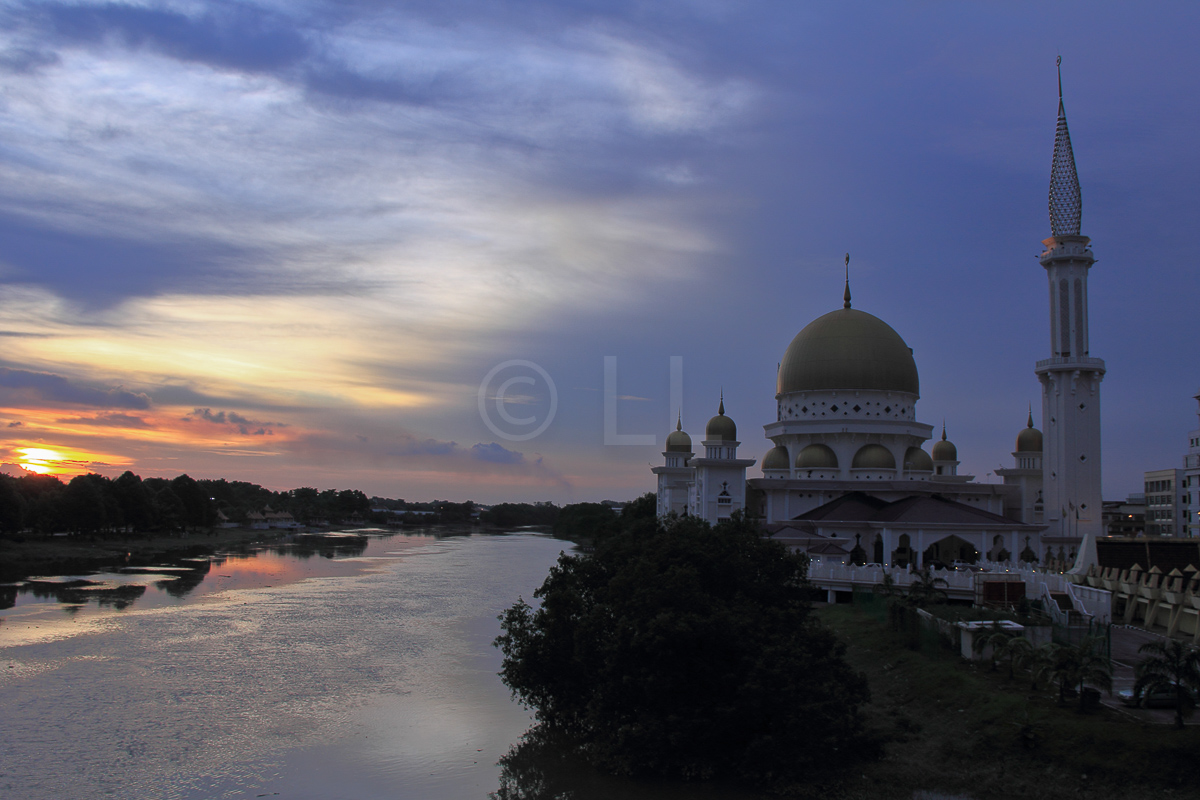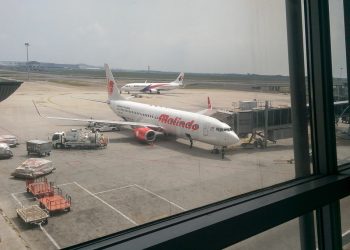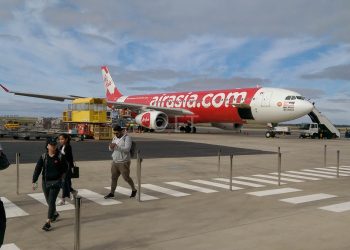October is a great time to make a day trip to Klang, about an hour by KTM Kommuter from KL Sentral Station in Kuala Lumpur. The area is also well served by the Federal Highway, NKVE and KESAS Highways as well, but as parking is not easy to find and if you do find it, you need to pay by ticket, hourly. This is a good reason to leave the car at home, or park at one of the stations along the way and catch the train. Catch the train heading for Pelabuhan Klang (Port Klang) and get out at Klang.
October is good because this is the period leading up to the Hindu Festival of Lights Diwali, commonly called Deepavali in Malaysia. The festival in 2015 falls on 10th November. With one of the most extensive and well stocked Little India enclaves in the country, this is the best time and place to buy Indian clothes, jewellery, cooking needs and Indian sweets.
Klang isn’t likely to ever win the ‘tidy towns’ award, unfortunately, but in the older part of the town on the South side of the river are plenty of architectural remnants of the interaction of the different communities that built the area from the mid 1800s. So. What to see?
-
Chong Kok Kopitiam

Chong Kok Kopitiam After leaving the Railway Station, cross over the road (carefully, there are no crossings) and head down Jln Stesen. A couple of doors down on the left is one of the old town coffee shops / bars as indicated on the painted sign. It’s not at all fancy and if you can find a seat (or share) order hot/iced local coffee and kaya toast, half boiled eggs and perhaps a small packet of nasi lemak biasa (the basic coconut rice, hard boiled egg, peanuts, anchovies and sambal). This will set you back less than RM10 and you will be nicely full to start your walk. Look for the old clock, the old fans and the safe near the front counter that has clearly been there for many years. The original shop frontage is mostly hidden behind the foodstalls outside, but can be seen when they close shop in the afternoon.
-
Royal Gallery Museum

Royal Gallery Museum As you walk along left side of Jln Stesen, you will come to an elegant double story white building. This government building, designed along with a number of well known buildings in Kuala Lumpur by A B Hubback, has a chequered history since it was built in 1909. It has served as administrative offices both pre and post Independence and during the Japanese Occupation. After the new Selangor capital was built in the mid 1970s it housed police and town council offices.
After extensive renovations, it has, in recent years become the home of the Royal Gallery Museum with a wide range of well displayed information and artefacts belonging to the Selangor Royal family. Admission to the museum is free but it is closed on Tuesdays.
-
Jln Istana

Old Chartered Bank building When the Chartered Bank opened its doors in 1874 just over the road beside the Royal Gallery building, it was the first bank in Klang. The building was well made and when the bank sold the building and moved some years ago, it sat empty for quite a few years before taking on a new life as a store selling Indian clothing and goods. Although some of the original external decoration is difficult to find, the renovations uncovered a beautiful wooden staircase that was formerly hidden by a partition wall behind the banking tellers. Many of the internal features are still visible and as you browse among the beautiful saris, look up and around at the architectural details.
The Klang Club opened its doors to the European elite (mostly planters) in 1901 and was granted ‘Royal’ status a hundred years later, by the Royal Patron, the Sultan of Selangor. The first local members were admitted only in the 1950s. In the ‘early days, members would hold garden parties and watch the horse racing on a racecourse which was at the base of the hill below, where the town Stadium is now. Although it is a Private Members only Club, you may use the facilities if you have an affiliate membership or are taken in as a guest, which will enable you to see some of the original areas and decorations, including the old wooden staircase.
-
Istana Alam Shah, the Sultan’s Palace

Istana Alam Shah The Istana, which is rumoured to be haunted, was opened in 1960, replacing an original wooden building which was badly affected by termites. The Royal Mausoleum, where a number of the recent Royals, including the previous Sultan and Tunku Ampuan, are buried, can just be seen to the left of the main building. Until the mid 1980s, the Sultan, who had never favoured this as a primary residence, but used it as an office and for Investitures, had a 9 hole golf course in front of the palace. This made way for a rather impressive extension of the grounds (upward) to make more room for garden parties and events. The palace was also extensively renovated and enlarged. The Sultan Suleiman mosque beside the Mausoleum was opened in 1932 but is currently closed for renovation.
One of the first events to be held at the newly renovated palace was an afternoon tea for Queen Elizabeth and the Duke of Edinburgh, in Malaysia for GHOGM, the Commonwealth Heads of Government Meeting and hosted by the old Sultan.
-
Hospital Hill

Klang Convent School From the Palace, walk over the hill opposite and as you go round the hill you can look over the town while enjoying a walk in the shade. This is the site of the old Klang Hospital, an old low wooden building open to all, including assorted cats and pigeons. There was much relief when the new General Hospital was opened in 1985, some distance away and the old Hospital Hill gradually became a park.
As you walk down the hill, Our Lady of Lourdes Church and the Klang Convent will come into view. The former Mission school and the church both date from 1928. The school said goodbye to their last teaching nuns in the mid-1980s and has long been one of the premier schools in Klang.
-
Little India and the Chetty Padang

Fortune telling birds Little India and the nearby Chetty Padang (field) have a common history. Since around 1900 the area has been home to many Indian traders (plus some Chinese businesses, selling groceries, Indian food sweets garlands, goldsmiths and household goods stores. Not to mention all the clothing stores with beautiful saris and other forms of Indian dress.
- Look for colourful Kolam painted on the footpath and the fortune telling birds. There are also many garland makers and you can take home some beautiful and fragrant jasmine flower garlands. Stop over here for lunch – enjoy some thosai and dhall, or a substantial banana leaf meal. Generally eaten with the hands, it is polite when you are finished to fold the leaf towards you as a ‘thank you’ for the good food.

Sri Nagara Thendayuthapani temple The Chetty Padang takes its name from the local name given to the Chettiars of Tamil Nadu, India, who had many trading businesses in the old town in ‘the old days’.The men generally came alone to make their fortunes and many never returned to India, instead marrying local women and settling down in Malaya.Little India springs from these roots and the many businesses in the area grew to cater to the local Indian population. The Sri Nagara Thendayuthapani Hindu temple dominates one side of the padang, a field used for playing games in the evenings.
-
MPK and Raja Mahadi’s Fort

Raja Mahadi’s Fort 
Old bridge walking path If you walk up beside the padang, you can see the Majlis Perbandaran Klang (Town Council) buildings directly in front of you, but over the road. It is definitely NOT recommended to try and cross the road, so take a stroll around the road and back down towards the bridge. The hill on which the MPK building now stands, is the site of Raja Mahadi’s Fort, the white entrance of which is to the left of the bridge entrance. Raja Mahadi and Raja Abdullah were fighting for control of the rich tin traffic during the tin wars of the mid 1800s, with Raja Mahadi holding the high ground, and Raja Abdullah in his warehouse (Gedung Raja Abdullah) down by the river in town. In the end, Raja Mahadi prevailed with the help of Tengku Kudin (Tengku Diauddin) whose name lives on in the road of his name.
The Double Decker Bridge (Jambatan Kota) was opened in 1960 and soon outgrew its size. The legendary traffic jams meant that a new bridge joined it a little further upstream by the 1980s and by 1991, work was well underway on a new bridge beside the old one. The old double decker metal bridge still remains for foot and vehicular traffic and the upper deck is a good place to take photos of the Klang North mosque (Masjid Bandar Diraja Klang Utara) in Jalan Pasar on the North side of the river.
-
Klang Fire Station and Raja Abdullah’s Warehouse

Klang Fire Station While there quite a few things to see in the newer part of town on the north of the river, that’s more than enough for one day. To get back to the station, walk from the lower deck of the bridge, along the path beside the river and up the steps and over the railway line. Raja Abdullah’s Gedung is tucked in between the police flats and the Police station and for a few years in the 1970s was used as part of the police station, with a small lockup as well. The building was renovated and opened as a Tin Museum some years ago, but has been closed for a number of years and nobody seems to know if it will reopen. The other side of the Police Station is the Fire Station, a low and quite small building, but it’s been there in almost the same form since the 1890s. Nip across to have a quick peek at the Indian Mosque, which is in its third incarnation since the 1970s, a bit bigger and grander each time, and then cut through the back streets of Jln Stesen 1 or straight along Jln Tengku Diauddin for another look through little India.
-
Back to the Station

Chinese Medicine Shop The Klang Railway Station is one of the earliest built in Selangor in 1890, however it retains few of the original features. To the left of the station entrance you can see one of the old railway carriages from pre-commuter days. Most of the Bak Kut Teh (pork bone tea) stalls would probably be closed by this time of the afternoon, but if you are so inclined, there are quite a few in this part of town that are open earlier in the day if you want a late breakfast or lunch. This popular pork and herbal soup eaten with rice originated from Klang well over sixty years ago, originally enjoyed by Chinese working men needing a solid start to the day. It’s now popular with people from all walks of life and there are even Halal versions available (made with chicken) though you’re unlikely to find them in Klang. Look out for some of the old traditional shops, like this medicine shop, they are fast disappearing.
Free Royal Klang Heritage Walk
Actually, any time of year is a good time to visit and if you are wanting a little help with directions, there is a great (and even better – it’s free) guided walk on weekends.
Joining the walk is easy. Walk-in participants won’t be turned away, but if you’d like to register, you can call 03-5513 2000 to register with Tourism Selangor which has joined with the Klang Municipal Council to organise the walks. If you’re visiting from outside Malaysia,ask your travel agent for assistance.







This Post Has 0 Comments